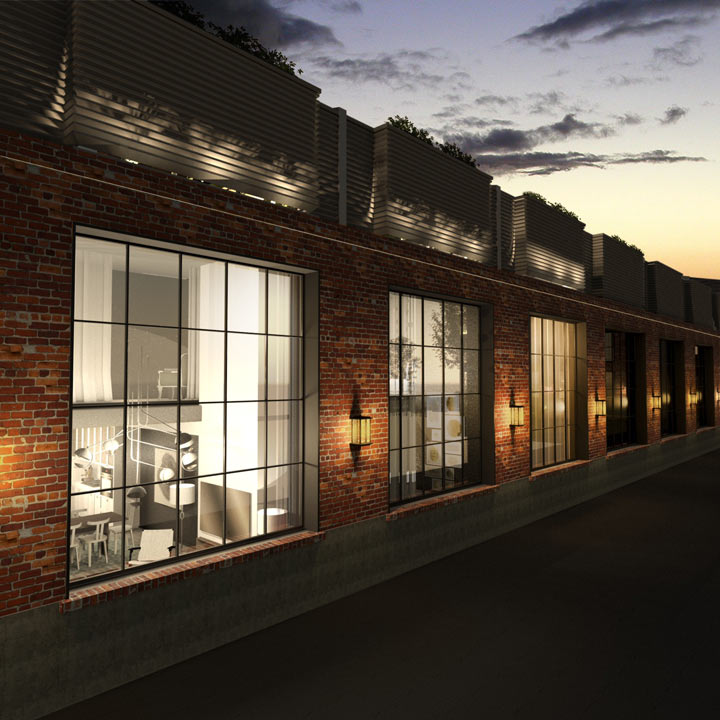Watch the video above: Laneway housing in Toronto on the rise. Mark McAllister reports.

TORONTO – The city of Toronto has hundreds of kilometres of laneways, tucked away behind houses, lined with car parks and waste bins.
While at times they’ve had a bad reputation – for crime and vandalism – developers and architects are looking at Toronto’s laneways as opportunities to build unique residential developments.
One development in particular, Lanehouse on Bartlett, is looking to be one of the first residential laneway developments of its kind in the city.
Developer Curated Properties want to turn a former factory into lofts and flats at 50 Bartlett Ave. in Toronto’s Bloordale neighbourhood.
The plan would see the former site of Pendell Boiler Ltd. transformed into 13 loft-style house and three single-floor flats, starting in the low $500,000s.
Initially the vacated property was marketed as a future site for townhomes, the existing building would have been demolished. But upon closer look, developers from Curated Properties decided they wanted to save the building.
“We decided to go the route of adaptive reuse,” said Adam Ochshorn, president of Curated Properties.
“We’ve been reconstituting the whole structure by reconditioning all the brick, reconstituting all the steel, making the structure a safer development,” he said.
Ochshorn said laneway-living has many advantages, one being that it’s a peaceful refuge in the heart of the city. “You’re not looking out at traffic, you’re not looking out at parked cars,” he said.
The site proposal, as well as a request for rezoning, is currently under review.
Ochshorn said they’ve had to work closely with city council and the planning department to address issues like shadows and privacy. “You don’t want people living above you and overlooking into your backyard,” said Ochshorn.
Toronto already has a few laneway houses, including single laneway homes on Croft Street (near College and Bathurst) and a laneway house at 2 Miles Place (near Christie and Dupont) that recently sold for $829,000.
But beyond a few examples, this type of development hasn’t been widely adopted in Toronto.
“This kind of aesthetic has been done in Europe for hundreds of years, it’s been done in various municipalities across North America,” said Ochshorn. “We feel that the time is right for Toronto to embrace this type of aesthetic.”
While Ochshorn believes the Lanehouse project will act as a trailblazer of sorts in the city he acknowledges that not all laneways are fit for such a development.
When it is a good fit, however, advocates argue these laneway developments are an innovative way to grow the city.
“It’s a very intelligent way for the city to accomplish their goals with respect to intensification and getting new housing stock built in the city in a way that is respectful of the urban form and the built form,” said Alex Sharpe, commercial real estate broker and co-founder of IQ Office Suites in Toronto.
Sharpe lives in a laneway house in the city’s east end. With his friend Craig Race, an intern architect at Sustainable T.O., they transformed a once-illegal unit into a legal dwelling in the middle of a vibrant neighbourhood.
But their plan wasn’t without resistance from the city.
“They call this a ‘house behind a house,’ and the city is very rigidly opposed to it,” said Sharpe.
Sharpe and Race took their design for the unit to the city’s Committee of Adjustment, which resulted in a letter from the planning department that opposed the entire project.
But with the help of a design that was thoughtful and mindful of the neighbourhood and the fact that the unit had been functioning as a dwelling unit for 16 years prior, they won approval from the committee.
“It’s a little bit strange in that you have to have something illegal and against the rules in order for it to become a little bit more appropriate and easy for the city to approve,” said Sharpe.
“I’m hopeful that when they see the product we’re able to finish and the lifestyle that I can live back here, it’s proof that it can work and it does work if it’s regulated and you’ve got frameworks,” said Sharpe.
In order to build laneway housing, builders must ask the city for zoning permission. City planning officials say many considerations have to be taken into account with laneway housing proposals, but the first question is always does the plan fit into the neighbourhood?
“One of our strongest policies is to maintain the character and scale of the neighbourhood,” said Lynda Macdonald, city planning manager with the City of Toronto.
Technical issues are also considered, including whether fire trucks and garbage trucks can reach the property.
“Laneways tend to be narrower, we don’t plough them in the winter, they usually don’t have any services in them,” said Macdonald.
Macdonald said there aren’t a lot of places in Toronto where they find laneway housing is appropriate, “because there aren’t that many places where you have an existing sort of laneway housing character.”
The proposal for Lanehouse on Bartlett Ave. is still in the beginning stages, but the developers hope that with approval from the city, the site will transform into a forward-thinking neighbourhood that holds on to the character of its past.












Comments